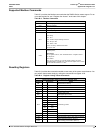
© 2011 Schneider Electric. All Rights Reserved.
PowerLogic
TM
Series 800 Power Meter 63230-500-225A2
Appendix C—Using the Command Interface 3/2011
88
Command Interface Control
• Set Control—To set control of conditional energy to the command interface:
1. Write command code 9020 to register 8000.
2. In register 3227, set bit 6 to 1 (preserve other bits that are ON).
3. Write 1 to register 8001.
4. Write command code 9021 to register 8000.
• Start— To start conditional energy accumulation, write command code 6321 to register
8000.
• Verify Setup—To verify proper setup, read register 1794. The register should read 1,
indicating conditional energy accumulation is ON.
• Stop—To stop conditional energy accumulation, write command code 6320 to register
8000.
• Clear—To clear all conditional energy registers (1728-1747), write command code
6212 to register 8000.
Digital Input Control
• Set Control—To configure conditional energy for digital input control:
1. Write command code 9020 to register 8000.
2. In register 3227, set bit 6 to 0 (preserve other bits that are ON).
3. Configure the digital input that will drive conditional energy accumulation. For the
appropriate digital input, write 3 to the Base +9 register.
4. Write 1 to register 8001.
5. Write command code 9021 to register 8000.
• Clear—To clear all conditional energy registers (1728–1747), write command code
6212 to register 8000.
• Verify Setup—To verify proper setup, read register 1794. The register should read 0
when the digital input is off, indicating that conditional energy accumulation is off. The
register should read 1 when conditional energy accumulation is on.
Incremental Energy
The power meter’s incremental energy feature allows you to define a start time, end time,
and time interval for incremental energy accumulation. At the end of each incremental
energy period, the following information is available:
• Wh IN during the last completed interval (reg. 1748–1750)
• VARh IN during the last completed interval (reg. 1751–1753)
• Wh OUT during the last completed interval (reg. 1754–1756)
• VARh OUT during the last completed interval (reg. 1757–1759)
• VAh during the last completed interval (reg. 1760–1762)
• Date/time of the last completed interval (reg. 1763–1765)
• Peak kW demand during the last completed interval (reg. 1940)
• Date/Time of Peak kW during the last completed interval (reg. 1941–1943)
• Peak kVAR demand during the last completed interval (reg. 1945)
• Date/Time of Peak kVAR during the last completed interval (reg. 1946–1948)
• Peak kVA demand during the last completed interval (reg. 1950)
• Date/Time of Peak kVA during the last completed interval (reg. 1951–1953)
The power meter can log the incremental energy data listed above. This logged data
provides all the information needed to analyze energy and power usage against present or
future utility rates. The information is especially useful for comparing different time-of-use
rate structures.
When using the incremental energy feature, remember that peak demands help minimize
the size of the data log in cases of sliding or rolling demand. Shorter incremental energy
periods make it easier to reconstruct a load profile analysis.


















